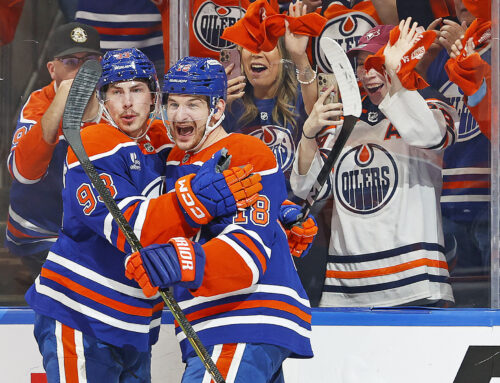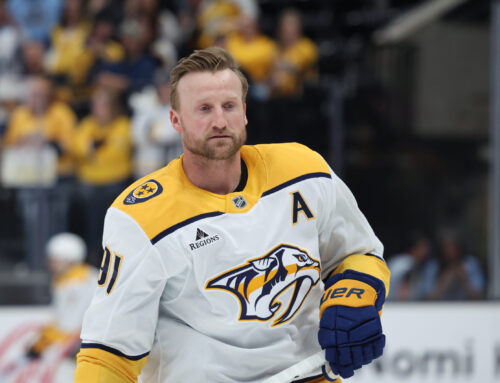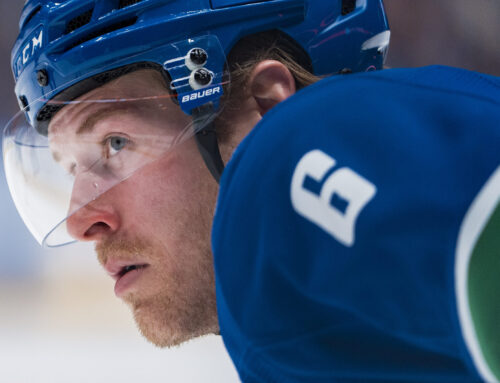
The offseason fantasy hockey outlooks for the San Jose Sharks and the St. Louis Blues
The final two teams are the two teams to make it to the Western Conference finals. Both are long embattled playoff underachievers, for San Jose it cost them their coach, Todd McLellan, last season while St Louis’ coach, Hitchcock, hangs by the thinnest of threads.
St Louis
Despite the fact that Blues had one of their most successful playoff runs in recent memory they are actually trending in the wrong direction. Offensively their shot rates have fluctuated over the last three years but have remained within a range to be expected of a Ken Hitchcock team. The Blues scored fewer goals this year but that is because their shooting percentage fell. They took more shots than they did in 2013/14 but scored fewer goals even though their expected goal rate was higher. Those kind of numbers suggest that there is reason to expect their goal rate to rebound but that will depend on how they fill the vacancies that free agency will likely create. The danger signs for the Blues are not on offense, where they would be expected on a Ken Hitchcock team, but on defense. That is surprising as a strong defense is the trademark of Ken Hitchcock teams. The Blues allowed nearly 30 shots per game this year after two years at around 26 shots per game. This jump in their shot allowed rate caused a proportional jump their expected goals against rate. The Blues were able to maintain a strong goals against rate because their goalies put up a better save percentage than they had in the previous two years. Thus the Blues were probably better than they got credit for offensively and not as good as they appeared by the numbers defensively.
In net the Blues have a brewing goalie controversy as Brian Elliott had a largely brilliant playoff run for a team that has done everything it could to give the reigns over to Jake Allen. It was evident again during this past regular season when Allen started six more games than Elliott despite Allen having a significantly better season. Elliott had a better save percentage a significantly better quality start percentage while facing a higher degree of difficulty as the Blues’ expected goals against rate with him on the ice was a third of a goal higher than when Allen was on the ice. Despite that the Blues still had a better goals against rate with Elliott on the ice than with Allen on the ice. While the difference is not as big normally as it was this year there is a track record of Elliott putting up better numbers than Allen. That being the case both goalies are free agents after this coming season and Allen is six years younger and as such clearly the future in St Louis, thus another year of platoon in the Blues’ is to be expected with both goalies continuing their strong play.
The Blues have a deep defense corps but there are very limited fantasy options within it. After Kevin Shattenkirk, Alex Pietrangelo and Colton Parayko there is not a lot to pick from on this blueline. Shattenkirk is the crown jewel of the defense but there have been lots of rumours floating around about a possible trade with him being an unrestricted after the 2016/17 season and the Blues being an internal budget team. Shattenkirk is the lone defenseman on the Blues top power play unit and gets usage that is tilted towards more offensive usage. There is a lot of reason to believe that Shattenkirk could be much better as his assist rate was extremely low this past year. The percentage of Blues goals he got an assist on was half to a third of what it has been in the first five years of his career. This dropped his point per 60 rate at even strength to half a point per 60 minutes at even strength to .5 from .8 the previous season and over one the year before that. Shattenkirk in St Louis should be counted on for 50 points. Should he get traded it will likely be Parayko and not Pietrangelo that is the big beneficiary. He will get the power play minutes that Shattenkirk currently gets and a similar type of usage overall. Parayko was a beast when Shattenkirk was out of the lineup early this past season taking shots at Brent Burns type rates. He would not immediately be a 50 point defenseman but his goal rate would be amongst the best goal scoring defensemen. Otherwise he will suffer a bit getting third pairing minutes and second unit power play time. Parayko also adds a ton of value in his production of peripheral stats. Pietrangelo given the kind of overall usage he gets is basically a 40 point defenseman. Pietrangelo produces at a very high level at even strength but he does not get the power play production or minutes to be an elite offensive defenseman. To put this into perspective he scores at even strength as well if not better than Oliver Ekman-Larsson (OEL) but cannot come close to matching OEL in power play production due to the aforementioned power play factors. The Blues have a budding peripheral category stud in Joel Edmundson as he already averages close to a penalty minute and a block per game as well as more than a hit per game.
Up front the Blues could lose two from their top nine but are deep enough for those potential losses not to have a huge effect. David Backes and Troy Brouwer are both well past their prime and coming big playoff runs that could boost their value on the free agent market. With Paul Stastny playing third line minutes and Dmitrij Jaskin playing just over 12 minutes per game and Berglund being best suited for a third line center role both can be easily replaced. This is especially relevant considering that retaining Backes alone could force the Blues to move Kevin Shattenkirk. Whether the Blues do or do not keep Backes, and/or Brouwer, it should not alter any general expectations of the rest of the Blues lineup.
The centerpiece of the Blues’ forwards is Vladimir Tarasenko. He is the only true superstar amongst the Blues forwards and the only threat to average a point per game over a season. This past season he took close to 300 hundred shots, averaging nearly four shots per game. With those kind of shot numbers he is basically a sure thing to get 30 goals barring a significant drop in his shooting percentage. The big question on the Blues is who plays with Tarasenko as everyone who plays with him is on for an extra goal per 60 minutes. This effect can be seen in the difference between Jori Lehtera’s 2014/15 and 2015/16 seasons. He played six more games this past season but produced 10 fewer points, 20 fewer shots and his shooting percentage dropped by three points. Lehtera seems like a good bet to land with Tarasenko again as he still played half of last season with Tarasenko. Jaden Schwartz missed a lot of last season and ended up playing less than 500 minutes at even strength. Half of those minutes were played with Tarasenko and Lehtera which bodes well for the possible reunion of the ‘STL’ line. On any other line he is good for 50 points whereas a full season on the ‘STL’ line could result in a 60 point season.
There are three other main fantasy options on the Blues in Alex Steen, Robby Fabbri and Paul Stastny. Alex Steen is probably the most consistent of those options both in terms of production and injuries although last year marked a definite decline. Steen is generally good for 50 points, a ton of power play time and 15 or more games missed due to injury. Steen’s shot rate dipped below three shots per game for the first time in six years despite this he is probably good for another 50 point season as he is a staple on the Blues’ top power play unit.
The Blues biggest addition last year was not Troy Brouwer but the arrival of Robby Fabbri. The Blues played higher event hockey with Fabbri on the ice, giving up more shots but also taking more shots in the process. He had a much greater effect on the Blues offense than he did on the defense and as such helped the Blues to carry the play even more. It will be interesting to see if Fabbri can continue his high shooting percentage ways as he only took a shot and a half per game. With the potential for significantly more ice time could easily break 50 points this coming season. Fabbri developed some late season chemistry with Paul Stastny and they were quite unlucky not to score more. They both saw their on-ice shooting percentage drop by more than two points along with a similar drop in their on-ice save percentage. This is a combination that has potential to put up some big numbers based on the shots the Blues generated when they were on the ice together. Stastny has a lot to gain from David Backes leaving as he would step up the lineup, and while it would not lead to much more ice time it would lead to more consistent linemates as he did not have a single linemate for more than 50% of his ice time.
A player to keep an eye on is Dmitrij Jaskin as he has some big multi-category potential. He averaged close to two hits per game this season, if he starts to get some more consistent playing time he could put up 30 points and 150 hits making him a sneaky good depth option as long as Brouwer and Backes leave.
San Jose
The Sharks returned to their puck possession ways this season even as their shot rate took a dip. The Sharks made significant improvements in their ability to suppress shots against. At 27.13 shots against per 60 minutes the Sharks posted their lowest shots against rate in the last five years. Some better goaltending during the regular season and they would have been an elite defensive team. As it was they allowed the third fewest shots, with the third fewest expected goals against, but the twelfth fewest goals against. The Sharks were a top offensive team in shots, expected goals for as well as actual goals, however they have shown in the past the ability to be even better. If there is a potential danger sign it is that they scored on a higher percentage of their than in any of the previous four seasons, by almost a full point.
While the Sharks overall save percentage was lower than it had been in past seasons it was not because of Martin Jones. A lot of the blame for the lower than normal save percentage can be placed squarely at the feet of Alex Stalock, but with him out of the picture that will change. Jones was slightly above league average but was even better during the playoffs and will no doubt be the workhorse once again. If the Sharks can even come close to matching their defensive prowess of last season he will post another season of big numbers. He now needs to be considered one of the best goalies in the Western Conference, which is not saying as much as it once did.
The Sharks have a deep defense but the fantasy relevance is limited to two players. Starting with the less obvious of the two Marc-Edouard Vlasic had a career year setting career highs in assists (31) and Points (39) even as he missed 15 games. Part of the reason for his sudden offensive output is that despite being used largely in a shutdown role he was also given more power play time than ever before in his career.as a result he hit double digit power play points for the third time in his career. His previous career season was based on extreme power play success whereas this season was based on being involved in the offense at a rate he never has been in the past. It helped that the Sharks scored on 10% of their shots when he was on the ice. Both of those factors point to a coming season of regression. Brent Burns also had a massive season but the danger signs are not nearly as prevlaebt in his case. Burns had a big season for one reason, he took 100 more shots than he ever has in his career. If Burns keeps taking almost 4.5 shots per game another 70 point season is certainly plausible, otherwise he will fall to around 60, based on his and the power play’s success there is no reason for him to shoot less. In multi-category leagues Brenden Dillon and Justin Braun are decent depth options.
The Sharks had five forwards with 40 points and Logan Couture would have been in that group had he not missed 30 games. The Sharks run a true top nine with scoring on every line plus Tommy Wingels kicking in the peripheral categories as well as 20 plus points. Owning a Shark toiling outside of the top nine is not worth it unless you can afford to hold them on the bench while waiting for an injury in the top nine.
The top line for the Sharks features the two Joes working in perfect harmony with Thronton dishing amazing passes and Pavelski getting open to help those passes find their way into the net. The best fit on this line has proven to be Tomas Hertl, who benefits in a big way because he often otherwise finds himself on the third line. The two Joes and Hertl as a line average nearly four goals per 60 minutes at even strength, which is an elite rate. That production rate was good enough to rank third in the league amongst line combos with more than 400 minutes together. Pavelski and Thornton will be fine no matter what as Thornton’s game is about as ageless as it gets, but Hertl needs to be on the top line to have a shot at breaking 50 points.
The rest of the Sharks’ top nine is a basically a jumble of moving parts with very few of them spending extended amounts of time together. That is likely partially to do with Logan Couture having missed 30 games. With the amount of power play time Couture receives he produces at basically the same rate as many of the first line centers across the league. His production rate was off this past season as he saw almost two minutes less ice time per game but that will no doubt change next year as it did during the playoffs. Couture and Joonas Donskoi had a lot of success together in the playoffs.and are a good bet to skate together next year but Donskoi is at best a 40 point player. He does not shoot enough or get top unit power play time to produce at the same levels as Couture.
Patrick Marleau and Joel Ward more or less round out the point producer portion of the top nine. Of the two Marleau has the most potential to put up big numbers as he is the fifth member of the top power play unit. Marleau though is not nearly as involved in the offense as the other four members of the top unit. Marleau is clearly in decline as the past two years his shot rate has slipped below three per game. Marleau slipped below 50 points this past season despite posting his highest shooting percentage in six years. As Marleau is slipping Ward just keeps chugging along posting basically the same numbers year after year. As such until his underlying numbers start to slip noticeably pencil him in for 35-45 points. Marleau on the other could break 50 with some luck but something around 45 is more likely.





 EDM
EDM FLA
FLA COL
COL MIN
MIN DAL
DAL ANA
ANA CBJ
CBJ VAN
VAN CAR
CAR
